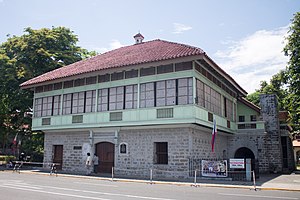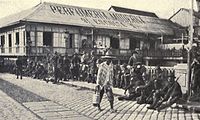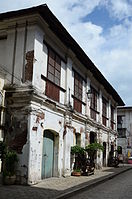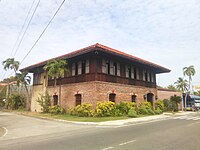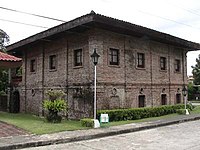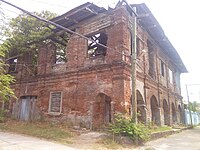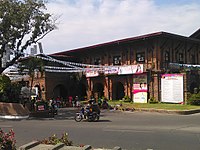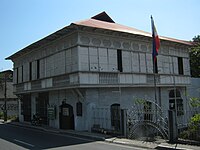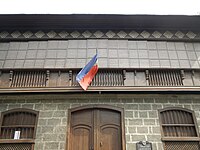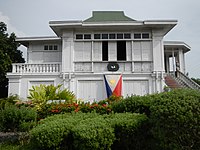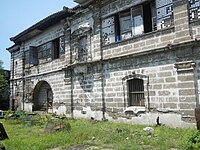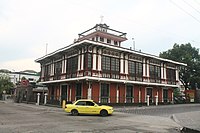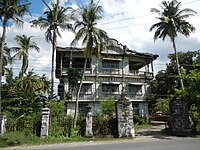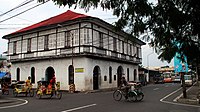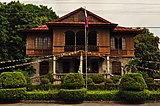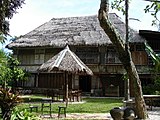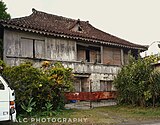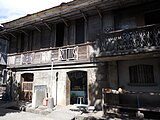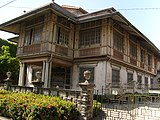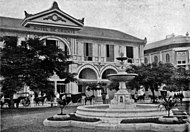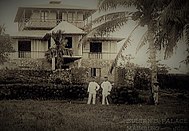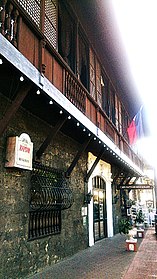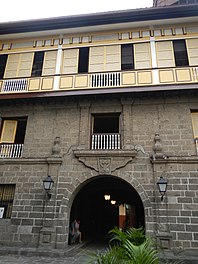
Spanish colonial architecture represents Spanish colonial influence on New World and East Indies' cities and towns, and it is still seen in the architecture as well as in the city planning aspects of conserved present-day cities. These two visible aspects of the city are connected and complementary. The 16th-century Laws of the Indies included provisions for the layout of new colonial settlements in the Americas and elsewhere.

The Baroque Churches of the Philippines are a collection of four Spanish Colonial-era baroque churches in the Philippines, which were included in UNESCO's World Heritage List in 1993. The churches are also considered as national cultural treasures of the country.

The bahay kubo, kubo, or payag is a type of stilt house indigenous to the Philippines. It often serves as an icon of Philippine culture. The house is exclusive to the lowland population of unified Spanish conquered territories. Its design heavily influenced the colonial-erabahay na bato architecture.
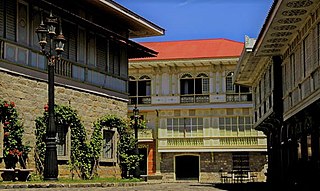
The architecture of the Philippines reflects the historical and cultural traditions in the country. Most prominent historic structures in the archipelago are influenced by Austronesian, American architectures.

The Quema House is the ancestral home of the Quema family in the Philippines. Built in the 1820s, it is a historic landmark in the town of Vigan, Ilocos Sur in the Philippines. The town itself was declared a UNESCO World Heritage Site in 1999.

Ancestral houses of the Philippines or Heritage Houses are homes owned and preserved by the same family for several generations as part of the Filipino family culture. It corresponds to long tradition by Filipino people of giving reverence for ancestors and elders. Houses could be a simple house to a mansion. The most common ones are the "Bahay na Bato". Some houses of prominent families had become points of interest or museums in their community because of its cultural, architectural or historical significance. These houses that are deemed of significant importance to the Filipino culture are declared Heritage House by the National Historical Commission of the Philippines (NHCP), previously known as the National Historical Institute (NHI) of the Philippines. Preservation is of utmost importance as some ancestral houses have come into danger due to business people who buy old houses in the provinces, dismantle them then sell the parts as ancestral building materials for homeowners wishing to have the ancestral ambiance on their houses. These ancestral houses provide the current generation a look back of the country's colonial past through these old houses.

Don Catalino Rodriguez Ancestral House, also known as Villa Sariaya, is one of the three houses declared by the National Historical Institute of the Philippines as Heritage house in Sariaya, Quezon. It was owned by Don Catalino Rodriguez, Sariaya’s town Presidente from 1908 to 1909. The house occupies an entire block near the church park. Its main entrance faces south along Calle Daliz and is bounded by Calle Rizal on the west and Quezon Avenue on the east. This house has already been transformed into a Museum and visitors can choose to wear period costumes for reasonable fees and pose for souvenir photos. Don Catalino Rodriguez Ancestral House is listed as one of the Ancestral Houses in the Philippines, under Region IV-A.
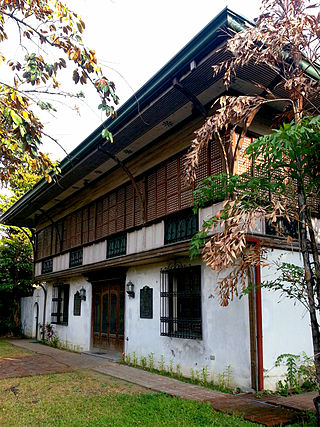
The Jose P. Laurel Ancestral House is a historic house in Manila, Philippines. It is one of the three houses owned by the President of the Second Philippine Republic, José P. Laurel. It is located in 1515 Peñafrancia Street in Paco District. President Laurel purchased the house in 1926 and served as his residence, together with his wife Pacencia Hidalgo and their children, for 29 years before he transferred to his retirement home in Mandaluyong.

The Vega Ancestral House is one of the 1st Transition Bahay na Bato inspired houses that has remained standing and has witnessed the different colonial periods of the Philippines through its estimated 200 years of existence. Sculpted wooden Atlases are perhaps the most interesting feature of this house that is located in Poblacion, Balingasag, Misamis Oriental. Sculpted wooden atlases, known as "Oti-ot" in the Visayan language, provide support to the second floor protrusion of the house. This house is one important structure in the locality that tourists usually come to visit. Notable personalities like Emilio Aguinaldo and Sergio Osmeña had visited this house.

The Hofileña Ancestral House is the residence of the late Manuel Severino Hofileña and his family located in Cinco de Noviembre Street, Silay City, in the province of Negros Occidental, Philippines. The home was built by Hofileña for his wife Gilda Ledesma Hojilla, a former Miss Silay, and their nine children.
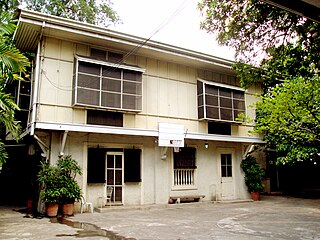
The Lichauco Heritage House, formally known as the O'Brien-Lichauco Heritage House is one of the oldest surviving houses in Santa Ana, Manila, Philippines. Originally built in 1859, the house was purchased in the late 1940s by a prominent Filipino lawyer and dignitary, Marcial Lichauco from a European family who had fled the Japanese occupation in the Philippines. The house was declared as a heritage house by the National Historical Commission on July 10, 2010. The Lichauco Heritage house is located along Pedro Gil Street. It is the only declared Heritage House in Santa Ana, and one of the only two declared heritage houses in Metro Manila along with Mira-Nila House in Quezon City.

The Bernardino Jalandoni Museum, also known as the Bernardino Jalandoni House, located along Rizal Street, Silay City, in the province of Negros Occidental, Philippines, is the original residence of the late Don Bernardino and Doña Ysabel Jalandoni. The museum is also known as the "Pink House" because of its conspicuous pink paint that easily grabs attention.
This is a list of historic houses in Santa Ana, Manila, the Philippines.

The Clarin Ancestral House is the residence of the Clarin family, a prominent family of politicians from Loay, Bohol, Philippines. It is arguably the most visited of all ancestral houses in Bohol, along with the President Carlos P. Garcia Heritage House in Tagbilaran.

The field of Indigenous architecture refers to the study and practice of architecture of, for and by Indigenous people. It is a field of study and practice in the United States, Australia, Aotearoa, Canada, Arctic area of Sápmi and many other countries where Indigenous people have a built tradition or aspire translate or to have their cultures translated in the built environment. This has been extended to landscape architecture, urban design, planning, public art, placemaking and other ways of contributing to the design of built environments.

The Nakpil-Bautista House is a bahay na bato ancestral home found in the district of Quiapo, Manila, the Philippines. It was built in 1914 by Arcadio Arellano. The house originally sat on two lots, having a total area of 500 square metres (5,400 sq ft).
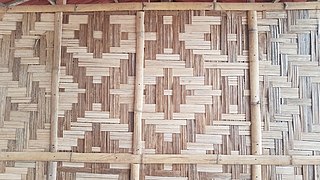
Amakan, also known as sawali in the northern Philippines, is a type of traditional woven split-bamboo mats used as walls, paneling, or wall cladding in the Philippines. They are woven into various intricate traditional patterns, often resulting in repeating diagonal, zigzag, or diamond-like shapes. The term "sawali" is more properly defined as twilled weaving patterns. The term can also be applied to baskets and banig, which also use the same weaving patterns. Amakan panels are commonly confused with pawid, which are made from thatched leaves.
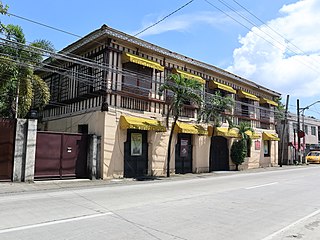
Camiña Balay Nga Bato, formerly known as Avanceña House, is a century-old heritage house in the Arevalo district, Iloilo City, Philippines. It was built in 1865 and was designed by the first parish priest of Molo, Anselmo Avanceña, for Don Fernando Avanceña and his wife, Eulalia Abaja. It was then passed on from one family to another until it came under the Camiñas family.[1] It is now owned by the fourth generation of the original owners, Gerard Camiña, former director of the Land Transportation Office in Western Visayas, and his wife, Luth Camiña. The ancestral house was declared as an Important Cultural Property by the National Museum of the Philippines (NMP) in 2015.
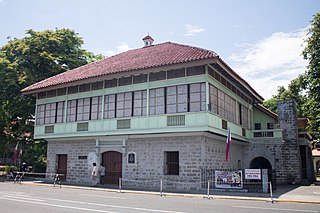
In Philippine architecture, the ventanilla is a small window or opening below a larger window's casement, created—often reaching the level of the floor—to allow either additional air into a room during hot days or some air during hot nights when the main window's panes are drawn. It also allows for more light to strike the floor.

The Father Burgos House, built in 1788, is a historic house in Vigan, Ilocos Sur, Philippines. It was the residence of the Filipino Catholic priest Jose Burgos (1837–1872), a leader of the secularization movement, referring to the full incorporation of Filipino priests into the Catholic hierarchy in the Philippines, which was dominated by Spanish friars in the past. Alongside two other Filipino priests, Mariano Gomez and Jacinto Zamora, Burgos was arrested on false charges of sedition and incitement of the Cavite mutiny and executed in 1872.
